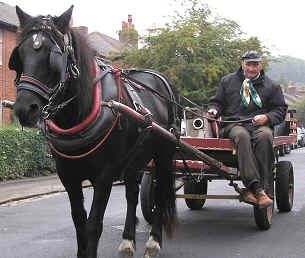
Everyone who is “of a certain age” will remember the rag and bone man. The heavy clip-clopping of horses’ hooves, punctuated by an indeterminate but oft-repeated cry, announced that it was time for children and their mothers to take their old unwanted apparel out into the quiet residential street, along perhaps with a cube of sugar for Dobbin. Who was always grateful.
Being a rag and bone man was a hard and not particularly rewarding life. He did take rags and bones (which had a surprising number of uses, including for making buttons!), but also a lot more besides. He was particularly fond of metal, which could be sold on for scrap. Although his apparent role was to “buy” our old junk, I don’t recall him ever handing me any money. I think perhaps I was paid in sweets, which seemed to work for me at the time.
In those days before synthetic fabric, most clothing was made from cotton or wool. This could be sold on to folks in the rag trade, who would typically pay two to three old pennies (1p) for a pound of cloth, just so long as it was clean.
Bone grubber
Although always known to us as the rag and bone man, the correct name for this occupation was “totter”. He was also known variously as a rag gatherer, a bone grubber, a bone picker and a chiffonnier.
His working day was long, and generally unforgiving. During the day anything potentially of value which he had found or was donated would pile up on the cart which was pulled by his horse, and would be sorted when he got home. Anything metallic would be of particular interest – brass, copper and pewter fetched about four to five old pennies per pound in weight at the turn of the twentieth century.
In a way giving our spare to the rag and bone man could be said to have been an early version of recycling. Old unwanted clothing and suchlike which might otherwise have finished up in the general waste ended up being sold to a trader to use again instead. Every one’s a winner.
Still a thing
Rag and bone was still a “thing” well into the 1970s, although by this time the trade had begun to fall into decline. Every area had at least one, and our familiarity with them was cemented by the adventures of two of the most famous totters of them all – from the hit British sitcom Steptoe and Son, played by Wilfrid Brambell and Harry H. Corbett (the “H” serving to differentiate the younger Steptoe from the Sooty and Sweep puppeteer Harry Corbett).
Times change, and some of those rag and bone men who found keeping a horse impractical began to operate instead from motorised transport. But it was a dying trade, unlikely ever to survive the enthusiasm for recycling and the move to more synthetic materials for clothing.
By the 1980s it had become unusual to see a rag and bone man at all, and most young people today would respond to any mention of one with a look of some bemusement. Just one more sadly gone relic from a bygone era of honest endeavour.

If you enjoyed reading this article, make sure you stay updated with all Phil’s latest blog posts by signing up to receive his free Newsletter. You can unsubscribe at any time and your details will never be shared with any third party. Click here to sign up today.
As a young child in the 50s living in Northampton my first comic was Jingles, published once a fortnight (owing to the paper shortage after the war) and costing 3d (old money). Precious, never thrown away, each edition of Jingles was stored carefully, rolled up, under my bed. To my horror, one lunchtime, I came home from school to find my mother had given my entire collection away to the rag and bone man. He appeared in our neighbourhood most weeks slowly leading his horse-drawn vehicle crying ‘Rag Bone, Rag Bone’ in order to get people’s attention. He collected old rags and newspapers to recycle into newsprint at the town’s newspaper offices. Bones had once been collected to extract grease to make soap. My mother obviously thought she was helping the recycling effort (even in those days) by clearing all the newsprint from under my bed. I couldn’t believe what she had done. I loved my comics so much.
I have memories as a young kid of the tag and bone man coming down Hanworth road in Hounslow. I don’t know how old I was maybe 5 or 6 so I guess it was sometime between 69 and 73, I don’t think it was much longer after that that I never heard it again. I remember the call through, which was more than rahdenbhwone rather than rag and bone.